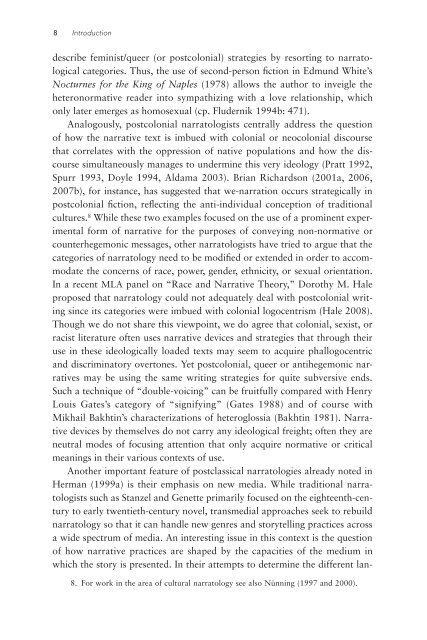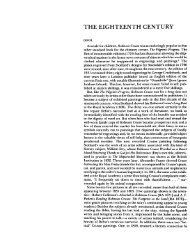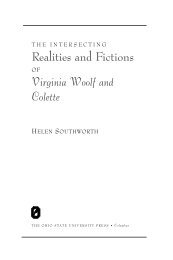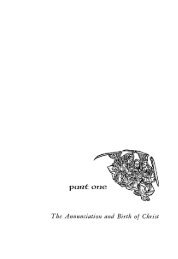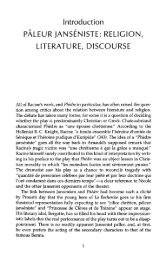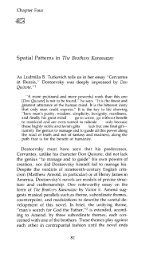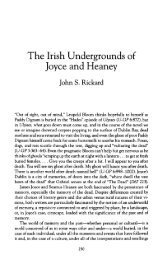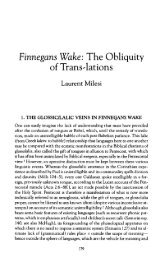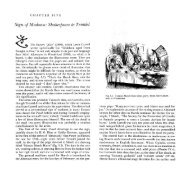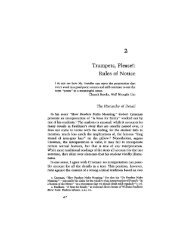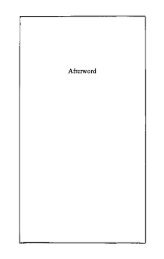Postclassical Narratology: Approaches and Analyses
Postclassical Narratology: Approaches and Analyses
Postclassical Narratology: Approaches and Analyses
Create successful ePaper yourself
Turn your PDF publications into a flip-book with our unique Google optimized e-Paper software.
8 Introduction<br />
describe feminist/queer (or postcolonial) strategies by resorting to narratological<br />
categories. Thus, the use of second-person fiction in Edmund White’s<br />
Nocturnes for the King of Naples (1978) allows the author to inveigle the<br />
heteronormative reader into sympathizing with a love relationship, which<br />
only later emerges as homosexual (cp. Fludernik 1994b: 471).<br />
Analogously, postcolonial narratologists centrally address the question<br />
of how the narrative text is imbued with colonial or neocolonial discourse<br />
that correlates with the oppression of native populations <strong>and</strong> how the discourse<br />
simultaneously manages to undermine this very ideology (Pratt 1992,<br />
Spurr 1993, Doyle 1994, Aldama 2003). Brian Richardson (2001a, 2006,<br />
2007b), for instance, has suggested that we-narration occurs strategically in<br />
postcolonial fiction, reflecting the anti-individual conception of traditional<br />
cultures. 8 While these two examples focused on the use of a prominent experimental<br />
form of narrative for the purposes of conveying non-normative or<br />
counterhegemonic messages, other narratologists have tried to argue that the<br />
categories of narratology need to be modified or extended in order to accommodate<br />
the concerns of race, power, gender, ethnicity, or sexual orientation.<br />
In a recent MLA panel on “Race <strong>and</strong> Narrative Theory,” Dorothy M. Hale<br />
proposed that narratology could not adequately deal with postcolonial writing<br />
since its categories were imbued with colonial logocentrism (Hale 2008).<br />
Though we do not share this viewpoint, we do agree that colonial, sexist, or<br />
racist literature often uses narrative devices <strong>and</strong> strategies that through their<br />
use in these ideologically loaded texts may seem to acquire phallogocentric<br />
<strong>and</strong> discriminatory overtones. Yet postcolonial, queer or antihegemonic narratives<br />
may be using the same writing strategies for quite subversive ends.<br />
Such a technique of “double-voicing” can be fruitfully compared with Henry<br />
Louis Gates’s category of “signifying” (Gates 1988) <strong>and</strong> of course with<br />
Mikhail Bakhtin’s characterizations of heteroglossia (Bakhtin 1981). Narrative<br />
devices by themselves do not carry any ideological freight; often they are<br />
neutral modes of focusing attention that only acquire normative or critical<br />
meanings in their various contexts of use.<br />
Another important feature of postclassical narratologies already noted in<br />
Herman (1999a) is their emphasis on new media. While traditional narratologists<br />
such as Stanzel <strong>and</strong> Genette primarily focused on the eighteenth-century<br />
to early twentieth-century novel, transmedial approaches seek to rebuild<br />
narratology so that it can h<strong>and</strong>le new genres <strong>and</strong> storytelling practices across<br />
a wide spectrum of media. An interesting issue in this context is the question<br />
of how narrative practices are shaped by the capacities of the medium in<br />
which the story is presented. In their attempts to determine the different lan-<br />
8. For work in the area of cultural narratology see also Nünning (1997 <strong>and</strong> 2000).


